Analyzing Big Data in Information Systems: A Business Report
VerifiedAdded on 2023/06/09
|7
|1685
|422
Report
AI Summary
This report provides a comprehensive overview of big data within the context of information systems, discussing its characteristics, challenges, and available analytical techniques. It highlights how big data technology can support businesses, providing concrete examples of its application. The report delves into the five Vs of big data (volume, variety, velocity, veracity, and value) and examines the issues organizations face, such as inaccurate analytics, long system response times, and expensive maintenance. Furthermore, it explores how big data, incorporating both quantitative and qualitative variables, can be utilized to enhance decision-making, improve customer engagement, and drive competitive advantage. The report concludes by emphasizing the importance of big data for overall business development and efficiency, also includes a poster presentation as an appendix, illustrating key concepts discussed.
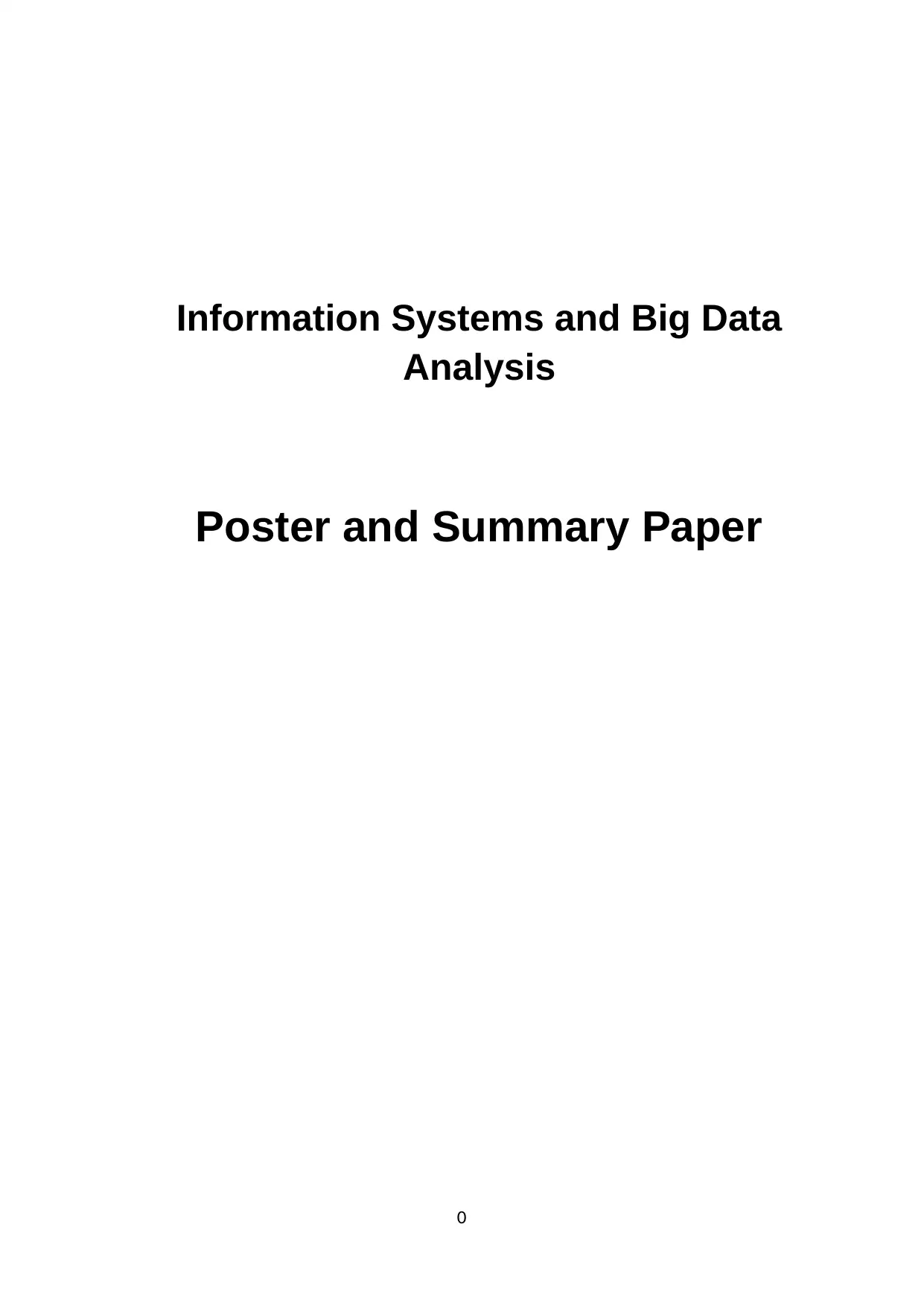
Information Systems and Big Data
Analysis
Poster and Summary Paper
0
Analysis
Poster and Summary Paper
0
Paraphrase This Document
Need a fresh take? Get an instant paraphrase of this document with our AI Paraphraser
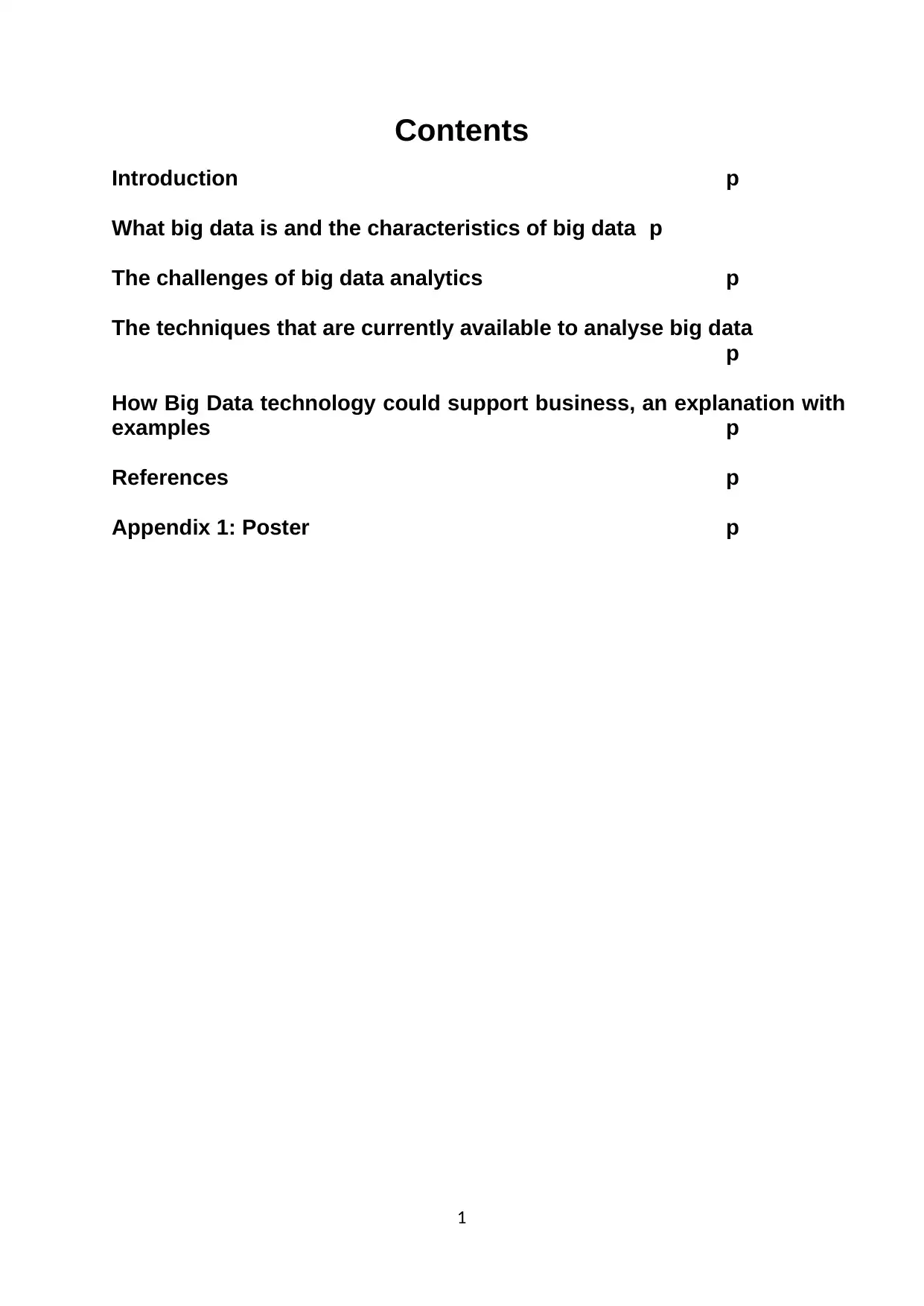
Contents
Introduction p
What big data is and the characteristics of big data p
The challenges of big data analytics p
The techniques that are currently available to analyse big data
p
How Big Data technology could support business, an explanation with
examples p
References p
Appendix 1: Poster p
1
Introduction p
What big data is and the characteristics of big data p
The challenges of big data analytics p
The techniques that are currently available to analyse big data
p
How Big Data technology could support business, an explanation with
examples p
References p
Appendix 1: Poster p
1
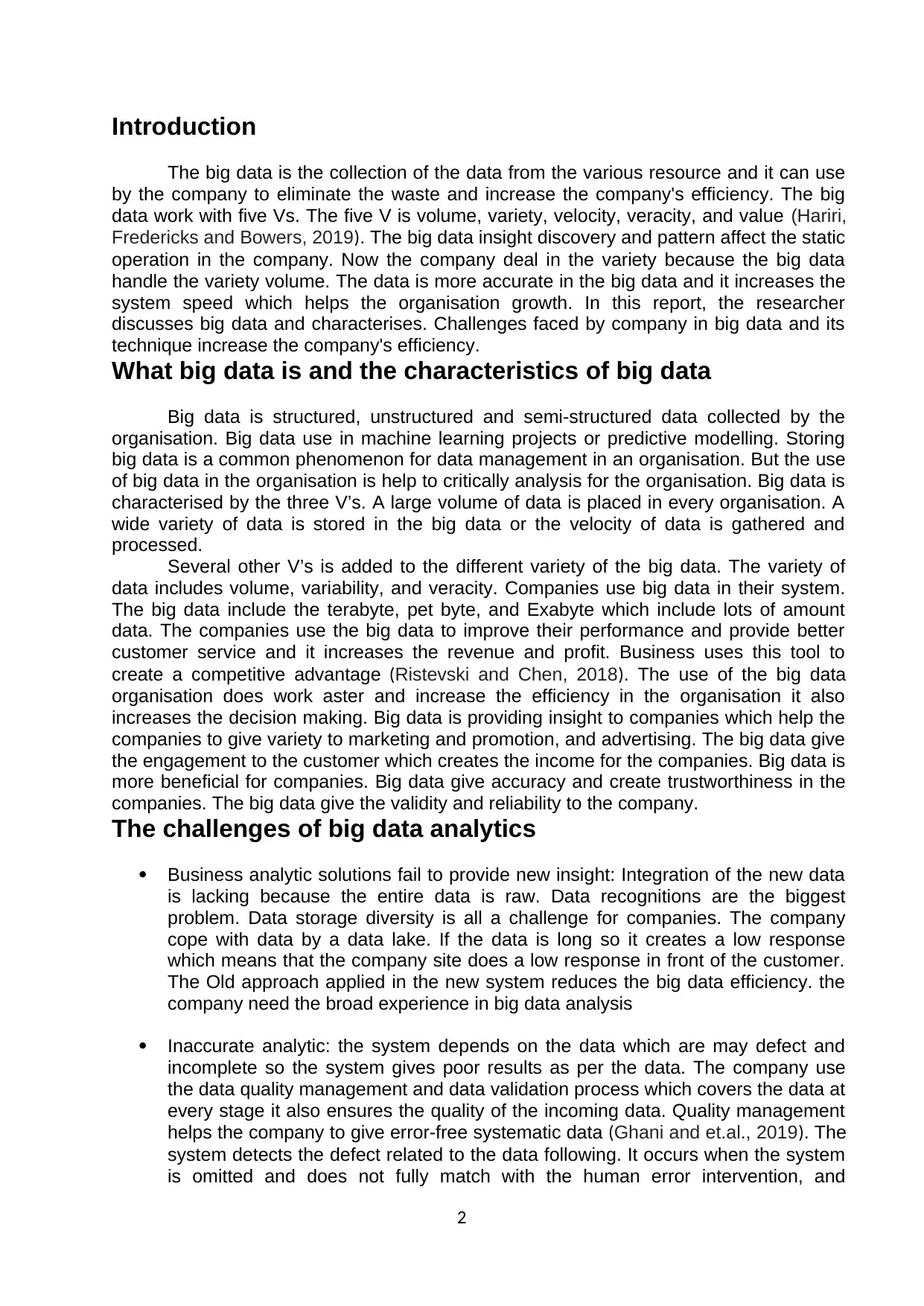
Introduction
The big data is the collection of the data from the various resource and it can use
by the company to eliminate the waste and increase the company's efficiency. The big
data work with five Vs. The five V is volume, variety, velocity, veracity, and value (Hariri,
Fredericks and Bowers, 2019). The big data insight discovery and pattern affect the static
operation in the company. Now the company deal in the variety because the big data
handle the variety volume. The data is more accurate in the big data and it increases the
system speed which helps the organisation growth. In this report, the researcher
discusses big data and characterises. Challenges faced by company in big data and its
technique increase the company's efficiency.
What big data is and the characteristics of big data
Big data is structured, unstructured and semi-structured data collected by the
organisation. Big data use in machine learning projects or predictive modelling. Storing
big data is a common phenomenon for data management in an organisation. But the use
of big data in the organisation is help to critically analysis for the organisation. Big data is
characterised by the three V’s. A large volume of data is placed in every organisation. A
wide variety of data is stored in the big data or the velocity of data is gathered and
processed.
Several other V’s is added to the different variety of the big data. The variety of
data includes volume, variability, and veracity. Companies use big data in their system.
The big data include the terabyte, pet byte, and Exabyte which include lots of amount
data. The companies use the big data to improve their performance and provide better
customer service and it increases the revenue and profit. Business uses this tool to
create a competitive advantage (Ristevski and Chen, 2018). The use of the big data
organisation does work aster and increase the efficiency in the organisation it also
increases the decision making. Big data is providing insight to companies which help the
companies to give variety to marketing and promotion, and advertising. The big data give
the engagement to the customer which creates the income for the companies. Big data is
more beneficial for companies. Big data give accuracy and create trustworthiness in the
companies. The big data give the validity and reliability to the company.
The challenges of big data analytics
Business analytic solutions fail to provide new insight: Integration of the new data
is lacking because the entire data is raw. Data recognitions are the biggest
problem. Data storage diversity is all a challenge for companies. The company
cope with data by a data lake. If the data is long so it creates a low response
which means that the company site does a low response in front of the customer.
The Old approach applied in the new system reduces the big data efficiency. the
company need the broad experience in big data analysis
Inaccurate analytic: the system depends on the data which are may defect and
incomplete so the system gives poor results as per the data. The company use
the data quality management and data validation process which covers the data at
every stage it also ensures the quality of the incoming data. Quality management
helps the company to give error-free systematic data (Ghani and et.al., 2019). The
system detects the defect related to the data following. It occurs when the system
is omitted and does not fully match with the human error intervention, and
2
The big data is the collection of the data from the various resource and it can use
by the company to eliminate the waste and increase the company's efficiency. The big
data work with five Vs. The five V is volume, variety, velocity, veracity, and value (Hariri,
Fredericks and Bowers, 2019). The big data insight discovery and pattern affect the static
operation in the company. Now the company deal in the variety because the big data
handle the variety volume. The data is more accurate in the big data and it increases the
system speed which helps the organisation growth. In this report, the researcher
discusses big data and characterises. Challenges faced by company in big data and its
technique increase the company's efficiency.
What big data is and the characteristics of big data
Big data is structured, unstructured and semi-structured data collected by the
organisation. Big data use in machine learning projects or predictive modelling. Storing
big data is a common phenomenon for data management in an organisation. But the use
of big data in the organisation is help to critically analysis for the organisation. Big data is
characterised by the three V’s. A large volume of data is placed in every organisation. A
wide variety of data is stored in the big data or the velocity of data is gathered and
processed.
Several other V’s is added to the different variety of the big data. The variety of
data includes volume, variability, and veracity. Companies use big data in their system.
The big data include the terabyte, pet byte, and Exabyte which include lots of amount
data. The companies use the big data to improve their performance and provide better
customer service and it increases the revenue and profit. Business uses this tool to
create a competitive advantage (Ristevski and Chen, 2018). The use of the big data
organisation does work aster and increase the efficiency in the organisation it also
increases the decision making. Big data is providing insight to companies which help the
companies to give variety to marketing and promotion, and advertising. The big data give
the engagement to the customer which creates the income for the companies. Big data is
more beneficial for companies. Big data give accuracy and create trustworthiness in the
companies. The big data give the validity and reliability to the company.
The challenges of big data analytics
Business analytic solutions fail to provide new insight: Integration of the new data
is lacking because the entire data is raw. Data recognitions are the biggest
problem. Data storage diversity is all a challenge for companies. The company
cope with data by a data lake. If the data is long so it creates a low response
which means that the company site does a low response in front of the customer.
The Old approach applied in the new system reduces the big data efficiency. the
company need the broad experience in big data analysis
Inaccurate analytic: the system depends on the data which are may defect and
incomplete so the system gives poor results as per the data. The company use
the data quality management and data validation process which covers the data at
every stage it also ensures the quality of the incoming data. Quality management
helps the company to give error-free systematic data (Ghani and et.al., 2019). The
system detects the defect related to the data following. It occurs when the system
is omitted and does not fully match with the human error intervention, and
2
⊘ This is a preview!⊘
Do you want full access?
Subscribe today to unlock all pages.

Trusted by 1+ million students worldwide
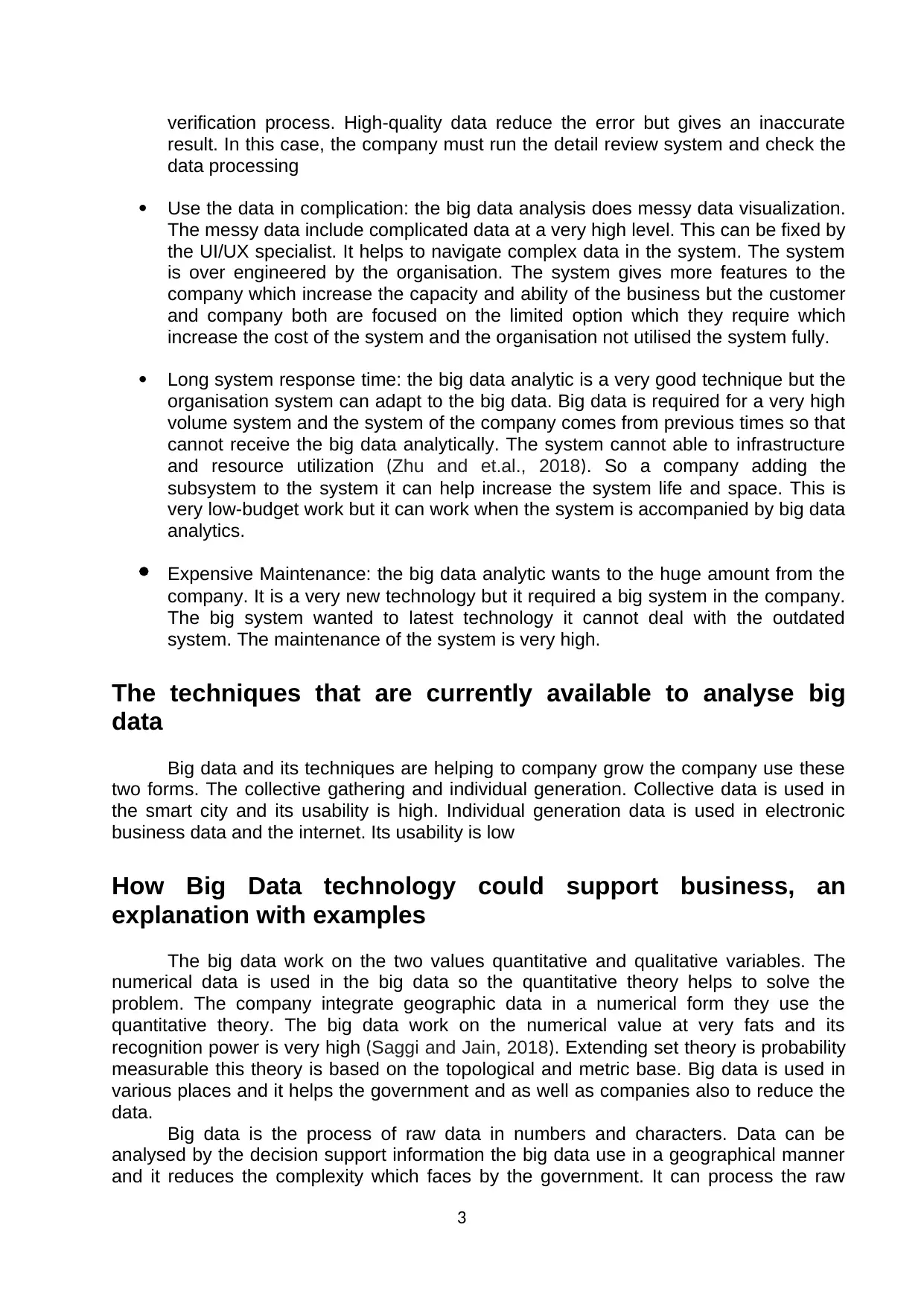
verification process. High-quality data reduce the error but gives an inaccurate
result. In this case, the company must run the detail review system and check the
data processing
Use the data in complication: the big data analysis does messy data visualization.
The messy data include complicated data at a very high level. This can be fixed by
the UI/UX specialist. It helps to navigate complex data in the system. The system
is over engineered by the organisation. The system gives more features to the
company which increase the capacity and ability of the business but the customer
and company both are focused on the limited option which they require which
increase the cost of the system and the organisation not utilised the system fully.
Long system response time: the big data analytic is a very good technique but the
organisation system can adapt to the big data. Big data is required for a very high
volume system and the system of the company comes from previous times so that
cannot receive the big data analytically. The system cannot able to infrastructure
and resource utilization (Zhu and et.al., 2018). So a company adding the
subsystem to the system it can help increase the system life and space. This is
very low-budget work but it can work when the system is accompanied by big data
analytics.
Expensive Maintenance: the big data analytic wants to the huge amount from the
company. It is a very new technology but it required a big system in the company.
The big system wanted to latest technology it cannot deal with the outdated
system. The maintenance of the system is very high.
The techniques that are currently available to analyse big
data
Big data and its techniques are helping to company grow the company use these
two forms. The collective gathering and individual generation. Collective data is used in
the smart city and its usability is high. Individual generation data is used in electronic
business data and the internet. Its usability is low
How Big Data technology could support business, an
explanation with examples
The big data work on the two values quantitative and qualitative variables. The
numerical data is used in the big data so the quantitative theory helps to solve the
problem. The company integrate geographic data in a numerical form they use the
quantitative theory. The big data work on the numerical value at very fats and its
recognition power is very high (Saggi and Jain, 2018). Extending set theory is probability
measurable this theory is based on the topological and metric base. Big data is used in
various places and it helps the government and as well as companies also to reduce the
data.
Big data is the process of raw data in numbers and characters. Data can be
analysed by the decision support information the big data use in a geographical manner
and it reduces the complexity which faces by the government. It can process the raw
3
result. In this case, the company must run the detail review system and check the
data processing
Use the data in complication: the big data analysis does messy data visualization.
The messy data include complicated data at a very high level. This can be fixed by
the UI/UX specialist. It helps to navigate complex data in the system. The system
is over engineered by the organisation. The system gives more features to the
company which increase the capacity and ability of the business but the customer
and company both are focused on the limited option which they require which
increase the cost of the system and the organisation not utilised the system fully.
Long system response time: the big data analytic is a very good technique but the
organisation system can adapt to the big data. Big data is required for a very high
volume system and the system of the company comes from previous times so that
cannot receive the big data analytically. The system cannot able to infrastructure
and resource utilization (Zhu and et.al., 2018). So a company adding the
subsystem to the system it can help increase the system life and space. This is
very low-budget work but it can work when the system is accompanied by big data
analytics.
Expensive Maintenance: the big data analytic wants to the huge amount from the
company. It is a very new technology but it required a big system in the company.
The big system wanted to latest technology it cannot deal with the outdated
system. The maintenance of the system is very high.
The techniques that are currently available to analyse big
data
Big data and its techniques are helping to company grow the company use these
two forms. The collective gathering and individual generation. Collective data is used in
the smart city and its usability is high. Individual generation data is used in electronic
business data and the internet. Its usability is low
How Big Data technology could support business, an
explanation with examples
The big data work on the two values quantitative and qualitative variables. The
numerical data is used in the big data so the quantitative theory helps to solve the
problem. The company integrate geographic data in a numerical form they use the
quantitative theory. The big data work on the numerical value at very fats and its
recognition power is very high (Saggi and Jain, 2018). Extending set theory is probability
measurable this theory is based on the topological and metric base. Big data is used in
various places and it helps the government and as well as companies also to reduce the
data.
Big data is the process of raw data in numbers and characters. Data can be
analysed by the decision support information the big data use in a geographical manner
and it reduces the complexity which faces by the government. It can process the raw
3
Paraphrase This Document
Need a fresh take? Get an instant paraphrase of this document with our AI Paraphraser
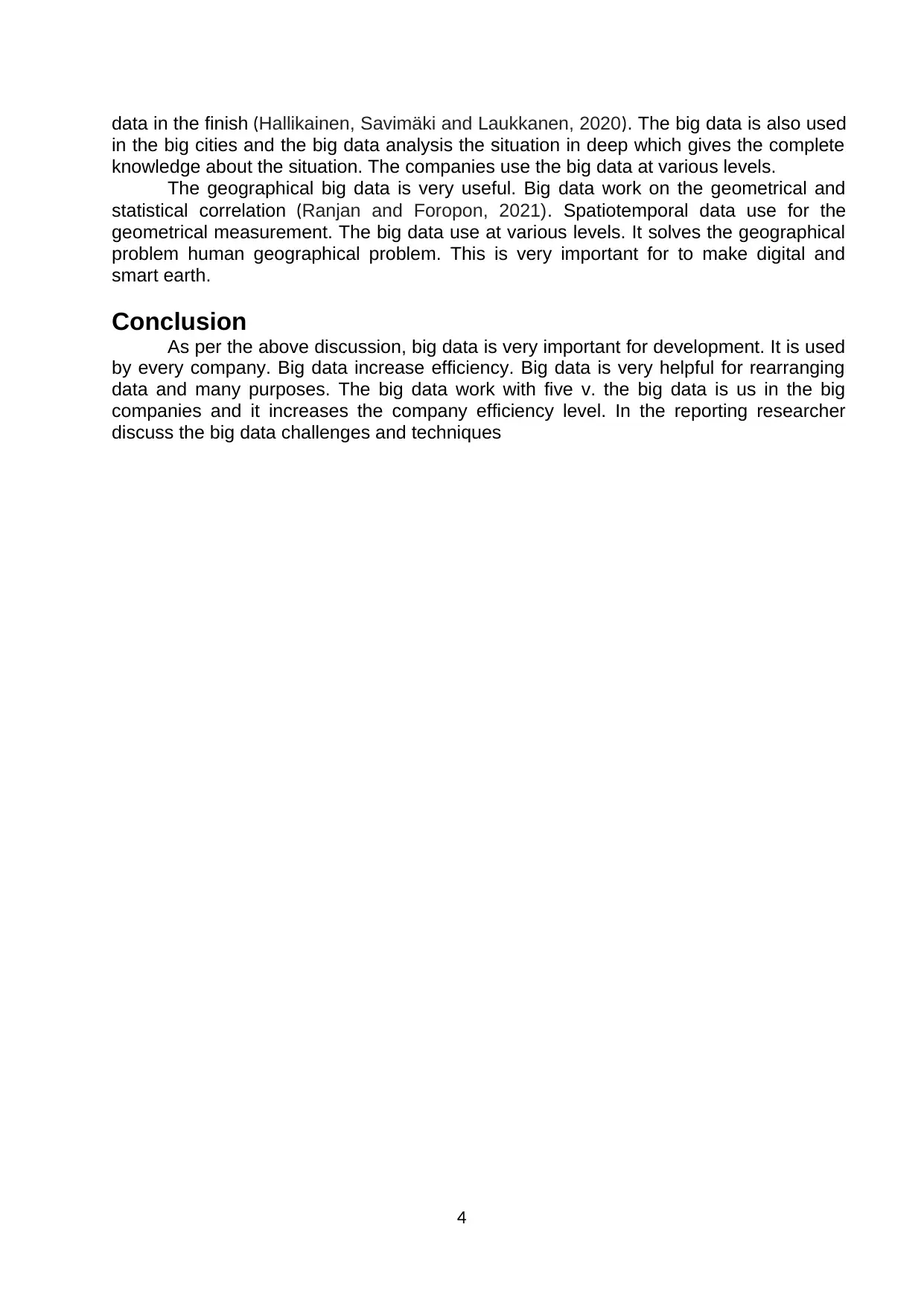
data in the finish (Hallikainen, Savimäki and Laukkanen, 2020). The big data is also used
in the big cities and the big data analysis the situation in deep which gives the complete
knowledge about the situation. The companies use the big data at various levels.
The geographical big data is very useful. Big data work on the geometrical and
statistical correlation (Ranjan and Foropon, 2021). Spatiotemporal data use for the
geometrical measurement. The big data use at various levels. It solves the geographical
problem human geographical problem. This is very important for to make digital and
smart earth.
Conclusion
As per the above discussion, big data is very important for development. It is used
by every company. Big data increase efficiency. Big data is very helpful for rearranging
data and many purposes. The big data work with five v. the big data is us in the big
companies and it increases the company efficiency level. In the reporting researcher
discuss the big data challenges and techniques
4
in the big cities and the big data analysis the situation in deep which gives the complete
knowledge about the situation. The companies use the big data at various levels.
The geographical big data is very useful. Big data work on the geometrical and
statistical correlation (Ranjan and Foropon, 2021). Spatiotemporal data use for the
geometrical measurement. The big data use at various levels. It solves the geographical
problem human geographical problem. This is very important for to make digital and
smart earth.
Conclusion
As per the above discussion, big data is very important for development. It is used
by every company. Big data increase efficiency. Big data is very helpful for rearranging
data and many purposes. The big data work with five v. the big data is us in the big
companies and it increases the company efficiency level. In the reporting researcher
discuss the big data challenges and techniques
4
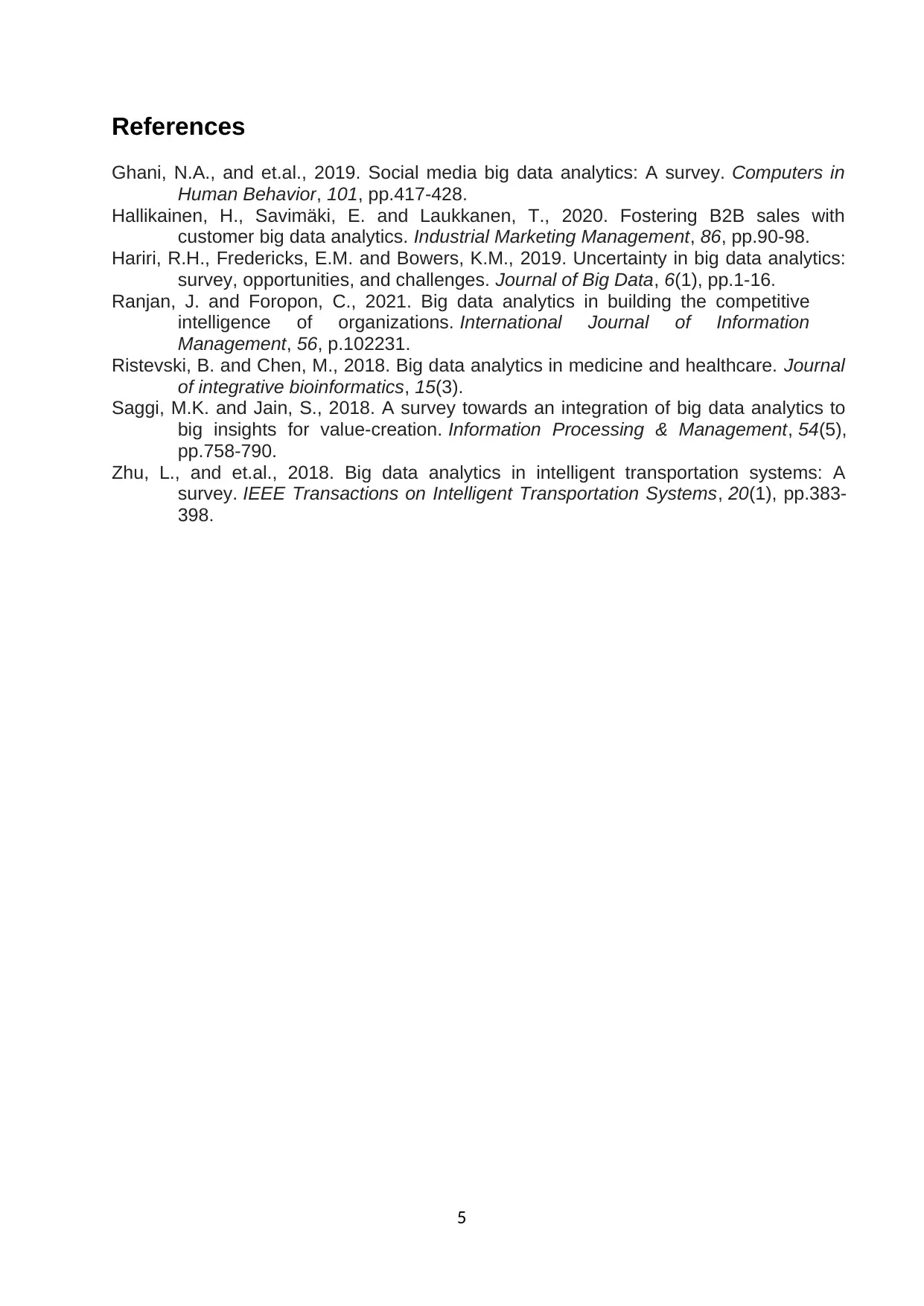
References
Ghani, N.A., and et.al., 2019. Social media big data analytics: A survey. Computers in
Human Behavior, 101, pp.417-428.
Hallikainen, H., Savimäki, E. and Laukkanen, T., 2020. Fostering B2B sales with
customer big data analytics. Industrial Marketing Management, 86, pp.90-98.
Hariri, R.H., Fredericks, E.M. and Bowers, K.M., 2019. Uncertainty in big data analytics:
survey, opportunities, and challenges. Journal of Big Data, 6(1), pp.1-16.
Ranjan, J. and Foropon, C., 2021. Big data analytics in building the competitive
intelligence of organizations. International Journal of Information
Management, 56, p.102231.
Ristevski, B. and Chen, M., 2018. Big data analytics in medicine and healthcare. Journal
of integrative bioinformatics, 15(3).
Saggi, M.K. and Jain, S., 2018. A survey towards an integration of big data analytics to
big insights for value-creation. Information Processing & Management, 54(5),
pp.758-790.
Zhu, L., and et.al., 2018. Big data analytics in intelligent transportation systems: A
survey. IEEE Transactions on Intelligent Transportation Systems, 20(1), pp.383-
398.
5
Ghani, N.A., and et.al., 2019. Social media big data analytics: A survey. Computers in
Human Behavior, 101, pp.417-428.
Hallikainen, H., Savimäki, E. and Laukkanen, T., 2020. Fostering B2B sales with
customer big data analytics. Industrial Marketing Management, 86, pp.90-98.
Hariri, R.H., Fredericks, E.M. and Bowers, K.M., 2019. Uncertainty in big data analytics:
survey, opportunities, and challenges. Journal of Big Data, 6(1), pp.1-16.
Ranjan, J. and Foropon, C., 2021. Big data analytics in building the competitive
intelligence of organizations. International Journal of Information
Management, 56, p.102231.
Ristevski, B. and Chen, M., 2018. Big data analytics in medicine and healthcare. Journal
of integrative bioinformatics, 15(3).
Saggi, M.K. and Jain, S., 2018. A survey towards an integration of big data analytics to
big insights for value-creation. Information Processing & Management, 54(5),
pp.758-790.
Zhu, L., and et.al., 2018. Big data analytics in intelligent transportation systems: A
survey. IEEE Transactions on Intelligent Transportation Systems, 20(1), pp.383-
398.
5
⊘ This is a preview!⊘
Do you want full access?
Subscribe today to unlock all pages.

Trusted by 1+ million students worldwide
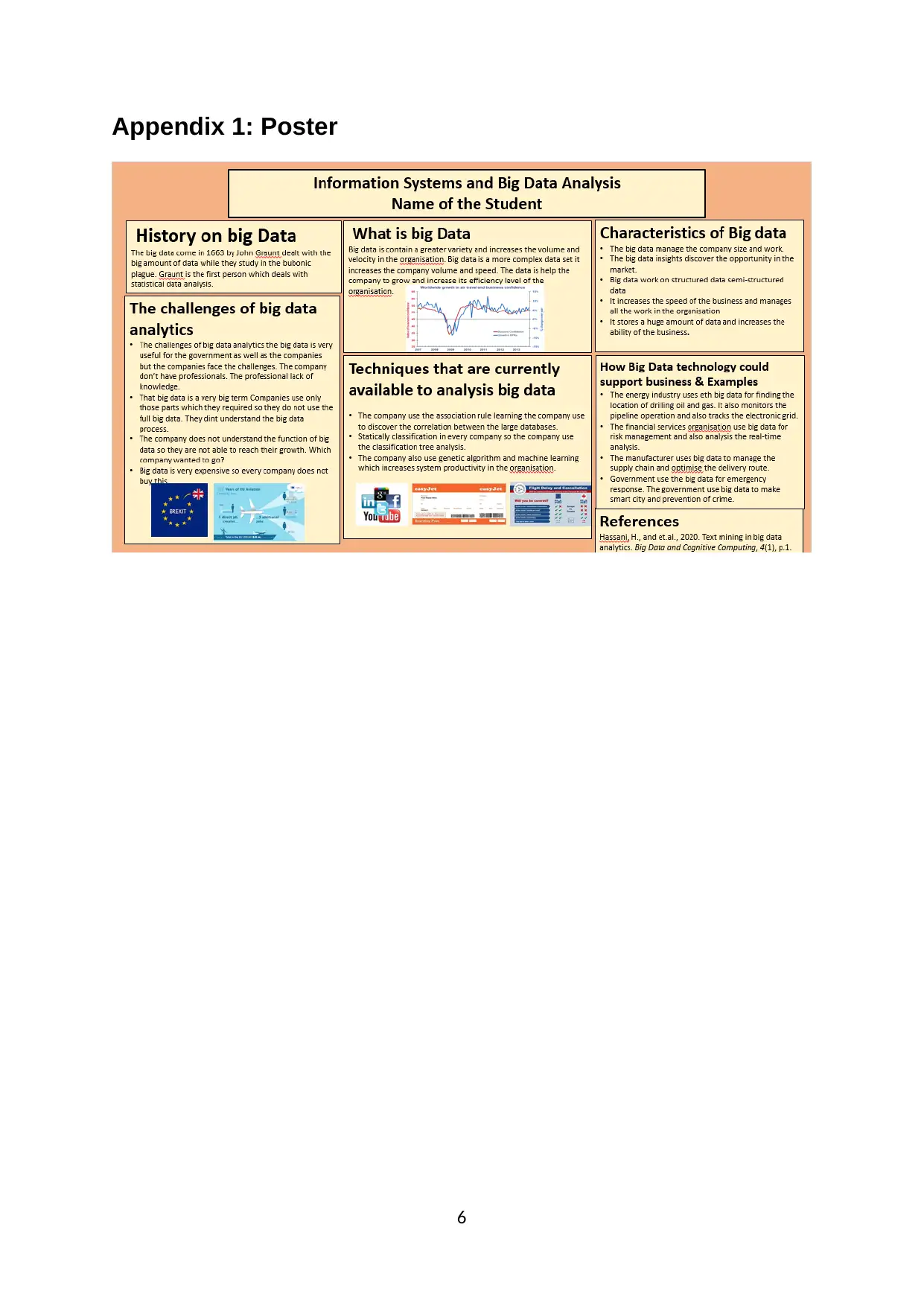
Appendix 1: Poster
6
6
1 out of 7
Related Documents
Your All-in-One AI-Powered Toolkit for Academic Success.
+13062052269
info@desklib.com
Available 24*7 on WhatsApp / Email
![[object Object]](/_next/static/media/star-bottom.7253800d.svg)
Unlock your academic potential
Copyright © 2020–2025 A2Z Services. All Rights Reserved. Developed and managed by ZUCOL.
